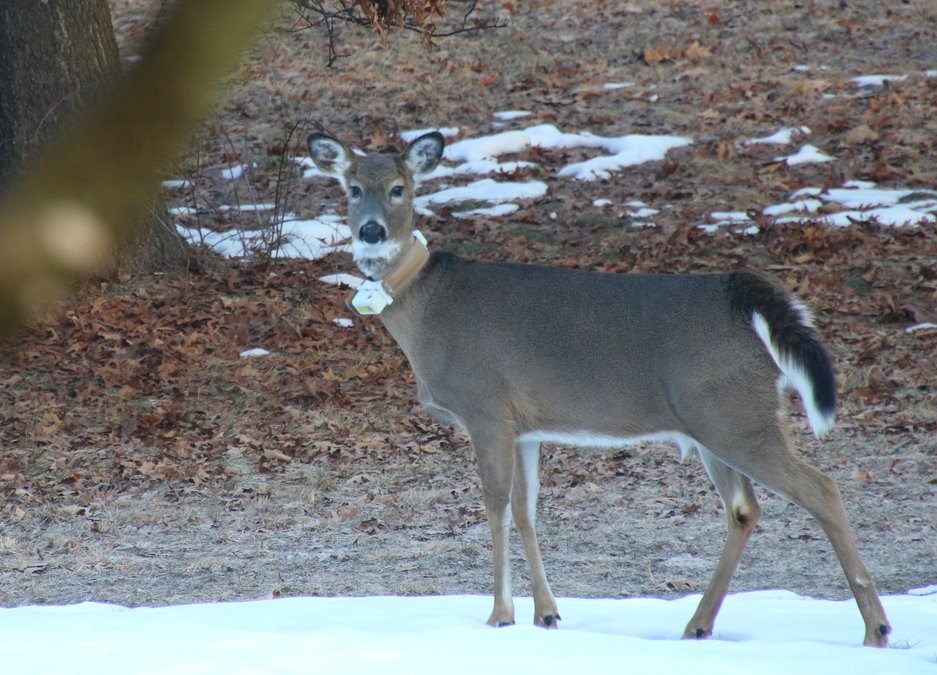University of Wisconsin-Madison deer researchers could only hope for cold temperatures and more snow so they could net and collar white-tailed deer, particularly bucks.
Amanda Puype, a limited term employee with the Wisconsin Department of Natural Resources, displayed two neck collars she and other members of a capture team affix to deer necks. Aside from a couple weeks of snow and cold, netting has been frustrating. The deer keep finding, and liking, natural stuff better than shelled corn and apples.
Thought of trying arbor vitae branches? Those seem to be the deer’s candy regardless of where the evergreen tree or shrub is planted.
The team, headed by Wendy Turner, a Ph.D Wildlife Research Biologist with the U.S. Geological Survey, and Senior Visiting Scientist in the Department of Forest and Wildlife Ecology at UW-Madison, is hoping to net and collar more deer who will then carry a GPS unit and a camera positioned to point forward from below the deer’s head.
The general purpose of this study, according to Turner, is to monitor who and how the deer interact with in different situations.
The camera does not transmit images from field locations, as the GPS unit does with away points. After a year, a small device will explode allowing the collar to come apart and drop off the deer’s neck. A signal from the collar is used to find the collar.
“This information will help to understand disease (chronic wasting disease) transmission and how and where it is happening,” Turner said.
The drop net capture is identical to a five-year deer study conducted by the WDNR; in fact Turner’s group is using the equipment Dan Storm, WDNR, used to capture and collar nearly 1,000 deer beginning in 2016.
“We’ve given our blessing and equipment to this study,” Storm said.
As with Storm’s study, collared deer should be treated by hunters as though they were not collared. In other words, shoot the deer if you would if the deer were not carrying a collar. Report the information (ear tag) to the DNR so the equipment can be retrieved.
One interesting encounter by Turner’s research team soon after a heavy snowfall in late January was when dropped the deer was able to use the deep snow to escape from under the net. In the process both his antlers caught the net and shed, obviously being about ready to fall. It isn’t often a deer observer sees an antler shed, let alone both.
They fell off simultaneously, too, but with the help of the net entanglement.
Sturgeon spearing through the ice on Lake Winnebago has been hampered to the point that spearing shanties on that lake and Upriver
lakes were minimal.
Opening day, February 10, counters observed 400 shanties, compared to more than 3,000 during recent years.
With fewer fish taken, it is unlikely the season will close before the actual end of spearing, February 25. A daily report is provided by the WDNR, In addition, statewide newspapers treat this one-of-a-kind event as unique.
The warmth, or maybe a shortage of food, too, has sent gray squirrels in search of a spring tonic, but just how much energy they are getting from boxelder bark can only be measured by the rodent.
From soil level to tree crown the squirrels have removed the thin bark, in shreds. A live tree region stays partially on the tree and partially on the bark piece so the squirrel can take some tissue from both areas. The process is complete girdling of the tree and it will die later this spring. A few may stump sprout.
Spring-like signs are showing, but too late for the recent heart holiday. Daffodils are poking through; skunk cabbage leaf shoots and floral buds have emerged, maple flower buds are expanding, and maple sap is flowing on sunny days weeks ahead of schedule.
Turkeys continue to shock gobble to crows, owls and clapping cupped hands. A new box call from Quaker Boy in New York has weight-shifted cherry lid, producing a more realistic yelp, but will gobblers notice the tone of this Hevy-HanD call?





